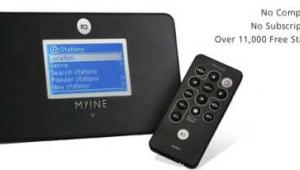A Shure Bet!

My readers aren't most people.
The Shure E4c are smack dab in the middle of Shure's relatively new line of earphones. Out for a few years now, I first ran into them at CEDIA 2005 in Indianapolis where Shure's manager of portfolio planning for the personal audio division (whew!), Christopher Lyons, was standing proudly in front of a tray of variously shaped colored tips that you could use while auditioning one of their earphones. I remember trying the E2c, E3c and E4c that day, albeit briefly. Prior to that encounter, my only experience with lossy compression music was my daughter's iPod, complete with the hard plastic "buds" that neither sounded good nor melded well with my ears.
I remember being taken aback as he played a Jeff Buckley song. I doubt the encoding on the iPod was set to anything other than Apple's default 128 kbs rate, but it still sounded so much better than anything I'd heard from my daughter's rig. Earphones make a huge difference. Even non-audiophiles spend more time picking speakers than any other audio component in their system. Why should earphones get any less scrutiny?
Christopher explained how Shure's earphone cord is supposed to wrap around your ear from the rear. I don't know why Shure designed their 'phones this way, but in practice, it's a comfortable arrangement with a serendipitous audiophile benefit. Wires are micro-phonic and they can convey a bit of low frequency huffing and chuffing as they scrap your checks and clothing. Doing the wrap minimizes this type of noise. The wires are more secure closer to your body where they can't slap around as much.
At $299 MSRP, the Shure E4c cost as much as the 30 GB iPod it's connected to. People look at me funny when I say that. I'm not sure why. Nobody thinks twice about spending as much or more on their speakers than on their receiver. The Shure E4c are high end speakers that fit in your ears.
In the ear is a much different experience than over the ears. First of all, isolating you from sound is double-the-decibels better than trying to cancel the sound around you like Bose and others try to do. I'm not saying sound cancelling technology doesn't work, but it makes for some king sized headphones you have to lug around. Plus, until I try them, I can't say for certain if sound cancelling headphones don't have the potential to cause as many problems as they solve.
Compared to traditional over the ear headphones like my inexpensive closed back AKG K-110Ms I picked up at a Sam Ash musical instruments store a few years ago, the Shure E4c are richer in the midrange and when jammed in deep enough, even better in the bass Of course, the AKG aren't Grados. I think any mid-grade Grado would best the Shures in the bass. That's to be expected.
I've used the Shure earphones only with the soft domelike silicon tips, though they provide a three tier pagoda style soft insert (similar to what Etymotic uses by default) as well as crushable/self-expanding foam. The silicon and foam tips come in three sizes. The foam ones should provide the highest degree of isolation, but I'm sort of queasy about the hygienic aspects. The silicones are easy to wipe down.
Or wet down. Forget what I said about hygiene. Here's something nobody is going to tell you about in their manual because, well frankly, it's gross, but it works. Put the silicon tips in your mouth to dampen them a bit before shoving them in your ear. Don't perform this feat in public. You'll lose friends, trust me, but it does work. Isolation is why the Shure's do as well as they do in the bass. After they're in deep enough (and wet enough) they will seal you off from your environment and give you a satisfying if not earth shattering level of bass. Shure claims 93% of noise reduction (37 db) for their lower priced E3c earphones verses a 77% reduction (20 db) for the Bose over-the-flap QuietComfort 2 heaphones.
And the Bose require batteries.
At the gym when I'm huffing and puffing, I set my iPod's EQ to R&B for a bit of bass and treble boost. It boosts my energy level too. The gym is also the place where I'm most likely to crank up the volume. At really loud levels, the pin head of a woofer in the Shure can distort a bit. Only the bass distorts though, and everything else stays quite linear. No harm, no foul, though and I seldom bother to back off the volume when this happens. The Shure appears no worse for the wear.
And while a little bit of saliva where the rubber meets the road is a good thing for bass, a rivulet of sweat making a beeline for your wax trax will only loosen your connection, especially if you're pulling and pushing on an elliptical as I'm often doing. But it's not a big deal.
The biggest difference between on-ear and in-ear, however, is the sense of immediacy and intimacy an in-ear provides. You don't have to listen loud, in fact, I rarely do. At lower levels, the sense of detail is amplified by the sense of isolation. In fact, I like to play a game of audio limbo – how low can you go? The Shure can go fairly low before your interest level wanes. That means, you can keep on enjoying music while still being able to somewhat hear what others around you are saying, or at least that they're saying something. It lets them think you care.
Elsewhere, the Shures are a little rolled off in the highest frequencies, but with a bit of a bump in the presence region (lower treble). They don't sound quite as extended in the treble as I'd like, lacking the slightest bit of air. The presence bump can make them less than forgiving with poor recordings when you push them too hard, but that is only at levels that wouldn't be healthy for long time periods anyway. During all my listening (except at the gym), you couldn't wipe the smile from my face.
After about a month, the only serious concern I have about the Shure cropped up when the left channel started cutting in and out. In a few days, the intermittent interruption became more or less permanent. Shure gives you a really cool case that let you store your earphones wrapped up and even though I always began my wrap from the less delicate phono plug end, the disconnect, the cable or connection to the left ear piece itself, failed. Shure should investigate better, heavier gauge cable. aesthetics be damned.
So far, the replacements have been with me to Japan and back without any problems. I'd like to see Shure give you a five year warranty instead of just a two year warranty – or at least offer a fixed price for all repair so customers would feel more confident in their purchase.
My flights to Denver in September and Tokyo in October were made not just tolerable, but down right enjoyable with my music collection in hand, so to speak. The Shure earphones were incredibly comfortable to wear for long periods of time without the least bit of discomfort. The drone of the jet's engines was 99% gone, all without the unsightly bulge on the head of my Bose equipped aisle mate.
But at the end of the day, it's the sound you come for and the Shure sure sound wonderful! They're about 80% as crisp as my Stax electrostatic phones, but I have trouble getting a 200 watt per channel amp and the Stax transformer box through airport security. It IS the bomb though.
The Stax have the most resolution of any phones I've heard, though. Nothing comes as close to pulling out details. Except for the bass, the Stax are more naturally balanced sounding, probably due to their ability to more quickly reproduce harmonics without being tripped up. Electrostatics are fast.
But the Shures have better bass and offer instant involvement. Put them on and wham – you don't have to shut your eyes, you're there! If a pig and a chicken decide to put together a bacon and egg breakfast, well, the chicken is involved, but the pig – the pig is committed. That's how it is with the Stax and the Shures. The Stax are involved. But the Shures – they're committed.
One of my upcoming projects is transferring some of my vinyl to CD and from there to the iPod. I'll be using the Shure E4c earphones because they're revealing, comfortable to wear and trustworthy. They may not be totally accurate (what is?), erring to the warm and comfortable side of things, but they're honest and never anything less than a true listening joy. The Shure E4c are highly recommended.
- Log in or register to post comments





























































